Conosciamo la sensazione. Quel momento di sconforto in cui il vostro sito va giù e non avete idea del perché. È uno degli errori più comuni di WordPress, ma anche uno dei più misteriosi. Non vi dice cosa c’è che non va, ma solo che qualcosa è rotto.
La buona notizia? È quasi sempre risolvibile. Avendo aiutato innumerevoli personalizzati, abbiamo avuto a che fare con questo errore molto spesso.
In questa guida vi illustreremo i passaggi esatti per ripristinare il vostro sito e renderlo funzionante. Seguiteci e vedrete che tutto tornerà a funzionare in pochissimo tempo.
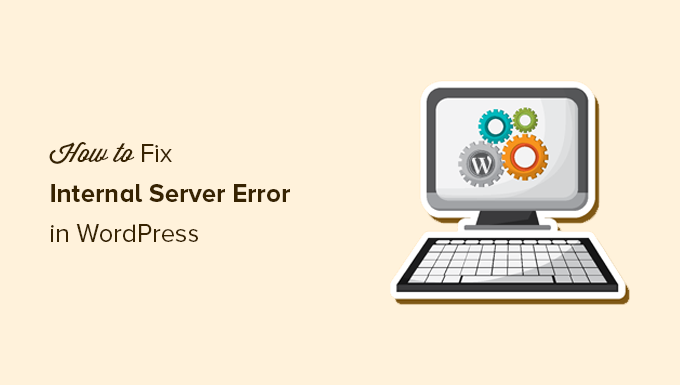
Ecco una rapida panoramica degli argomenti che tratteremo in questo articolo:
- What Is the 500 Internal Server Error?
- What Causes the Internal Server Error in WordPress?
- Fixing the 500 Internal Server Error in WordPress
- Clear WordPress and Browser Cache
- Checking for Corrupt .htaccess File
- Increasing the PHP Memory Limit
- Deactivate All WordPress Plugins
- Switch to a Default WordPress Theme
- Re-Uploading Core Files
- Enable Debug Logs in WordPress
- Ask Your Hosting Provider
- Video Tutorial
Che cos’è l’errore 500 Internal Server?
L’errore 500 Internal Server è come una porta bloccata senza chiave. Si sa che qualcosa non va, ma non c’è una nota che spieghi cosa è successo.
Questo errore non riguarda solo WordPress. Può apparire su qualsiasi sito web quando il server incontra un problema che non sa come gestire.
Il “500” nel messaggio è un codice di stato HTTP. Se lo cercate, troverete una definizione vaga:
“Il codice di risposta 500 Internal Server Error indica che il server ha incontrato una condizione inaspettata che gli ha impedito di soddisfare la richiesta”.
Non è molto utile, vero? È il modo in cui il server dice: “Si è rotto qualcosa, ma non sono sicuro di cosa”.
L’aspetto di questo errore dipende dalla configurazione dell’host e dal browser. Ecco un esempio di come appare su un server Apache:
Se il sito viene eseguito su Nginx, l’aspetto potrebbe essere leggermente diverso. Se Google Chrome non riesce a caricare una pagina di errore corretta, si vedrà qualcosa di simile:
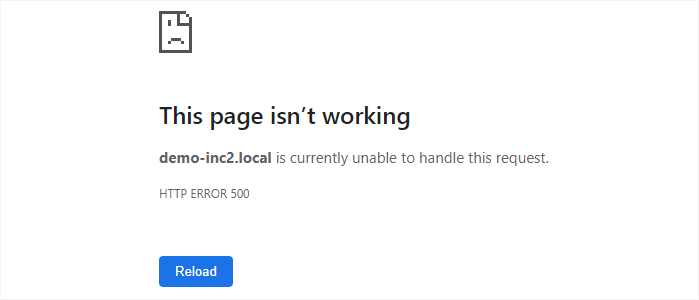
Per i principianti, questa situazione può risultare sconvolgente. Non c’è alcun messaggio che indichi cosa è andato storto o come correggerlo.
È come chiedere a un meccanico di correggere la vostra auto senza dirgli cosa è rotto. Dovranno controllare diverse parti fino a trovare il problema.
In base alla nostra esperienza, il modo migliore per correggere il problema è procedere passo dopo passo. Vi illustreremo le cause e le soluzioni più comuni per far sì che il vostro sito torni a funzionare.
Ottenete l’aiuto di un esperto in qualsiasi momento con il supporto WordPress on-demand!
Affrontare un errore interno del server può essere frustrante. Il nostro Supporto WordPress On-Demand è qui per aiutarvi a correggere i problemi tecnici in modo rapido ed efficace.
- Pagamento unico per l’assistenza on-demand di un esperto
- Tempi di consegna rapidi
- Disponibile 24 ore su 24, 7 giorni su 7
👉 O ttenete subito un supporto di emergenza per WordPress! 🛠️
Cosa causa l’errore interno del server in WordPress?
L’errore interno del server in WordPress è come un puzzle con pezzi mancanti. Sapete che qualcosa non va, ma il messaggio di errore non vi dice esattamente dove si trova il problema.
In base alla nostra esperienza, il colpevole più comune è un file .htaccess corrotto. A volte, si tratta di un plugin che si comporta male o di un tema che non funziona bene con la vostra configurazione.
Altre volte, il sito può colpire il limite di memoria PHP, causando il blocco di WordPress. Anche i file del core corrotti possono innescare questo errore, lasciandovi bloccati senza attenzione.
In alcuni casi, l’errore appare solo quando si cerca di accedere all’area di amministrazione di WordPress, mentre il resto del sito funziona correttamente. È come essere bloccati in casa propria mentre gli ospiti possono ancora entrare dalla porta sul retro.
Ciò che rende questo errore complicato è che di solito si verifica prima che WordPress possa essere caricato correttamente. Ciò significa che il server non può raccogliere abbastanza dettagli per spiegare cosa è andato storto.
Se volete dare un’occhiata più approfondita al funzionamento di WordPress dietro le quinte, consultate la nostra guida su come WordPress opera sotto il cofano.
Passiamo ora alla risoluzione dei problemi per ripristinare il funzionamento del sito.
Risolvere l’errore 500 Internal Server in WordPress
Prima di iniziare la risoluzione dei problemi, assicuratevi di avere a portata di mano un backup completo di WordPress del vostro sito web.
Se avete accesso all’area di amministrazione di WordPress, potete utilizzare un plugin di backup per WordPress per creare un backup completo del vostro sito web.
Per questo consigliamo di utilizzare Duplicator. Non solo vi aiuta a eseguire rapidamente il backup del vostro sito web, ma potete anche archiviare i vostri backup sul cloud e, soprattutto, potete ripristinare il vostro sito web dal backup.
D’altra parte, se non avete accesso all’area di amministrazione di WordPress, potete creare manualmente un backup di WordPress utilizzando phpMyAdmin e un client FTP.
In seguito, potete seguire i seguenti passaggi per risolvere il problema e risolvere l’errore del server interno sul vostro sito web.
Cancellare la cache di WordPress e del browser
I browser e i plugin di caching di WordPress possono talvolta memorizzare erroneamente una copia in cache di una pagina di errore.
Il modo più semplice per risolvere il problema è cancellare la cache del browser.
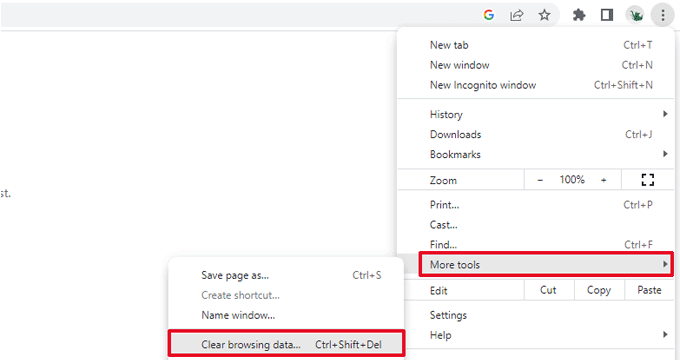
Dopodiché, se avete accesso all’area di amministrazione di WordPress del vostro sito web, potete svuotare la cache di WordPress visitando la pagina delle impostazioni del vostro plugin di caching.
Per maggiori dettagli, consultate il nostro tutorial su come cancellare la cache di WordPress.
Verifica della presenza di un file .htaccess corrotto
Il file .htaccess è un file di configurazione del server utilizzato da WordPress per impostare i reindirizzamenti.
Una delle cause più comuni di errore interno del server è il file .htaccess corrotto.
Il modo più semplice per correggere questo problema è semplicemente visitare la pagina Impostazioni ” Permalinks nell’area di amministrazione di WordPress e poi fare clic sul pulsante “Salva modifiche” senza apportare alcun cambiamento.
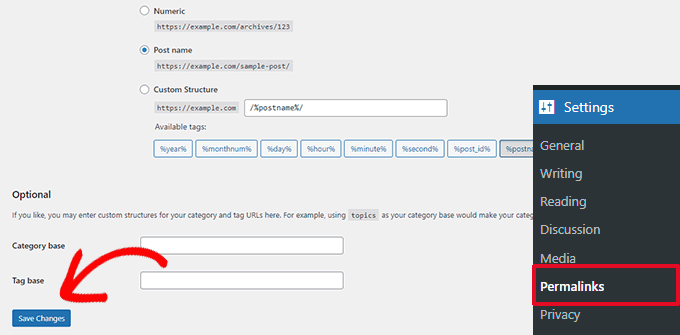
WordPress cercherà ora di aggiornare il file .htaccess o di generarne uno nuovo. Ora è possibile visitare il sito web per verificare se l’errore del server interno è stato corretto.
Se l’errore è ancora visibile, è necessario assicurarsi che WordPress sia stato in grado di generare o scrivere sul file .htaccess.
A volte, a causa delle autorizzazioni di file e directory, WordPress potrebbe non essere in grado di creare o scrivere sul file .htaccess.
Ora potete provare a sostituire il file .htaccess manualmente. Per prima cosa, dovete accedere al vostro sito web utilizzando l’FTP o l’applicazione File Manager nel pannello di controllo del vostro account di hosting.
Successivamente, è necessario rinominare ilfile .htaccess principale in qualcosa come .htaccess_old. Questo vi consente di mantenere il file come backup, ma WordPress non lo riconoscerà.
Per rinominare il file .htaccess, dovrete accedere al vostro sito utilizzando l’FTP o l’applicazione File Manager nel cruscotto del vostro account di hosting.
Una volta collegati, il file .htaccess si troverà nella stessa directory in cui sono presenti cartelle come wp-content, wp-admin e wp-includes.
È sufficiente fare clic con il tasto destro del mouse sul file .htaccess e rinominarlo in .htaccess_old.
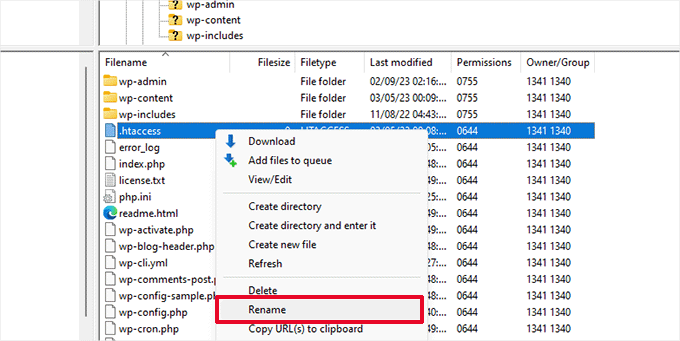
Successivamente, è necessario creare un nuovo file .htaccess.
All’interno della cartella principale del sito, fare clic con il tasto destro del mouse e selezionare l’opzione “Crea nuovo file” nel client FTP o nell’applicazione File Manager.
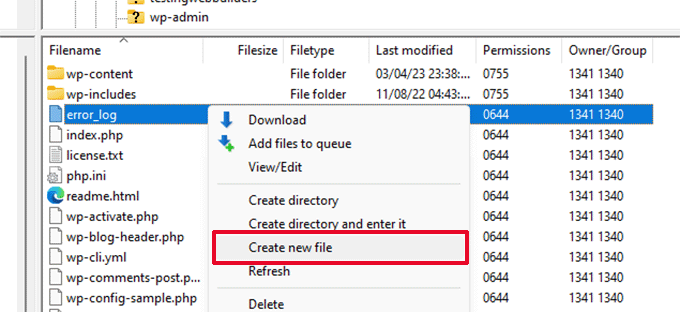
Nominate questo nuovo file .htaccess e fate clic su “OK” per salvarlo.
Ora, questo file .htaccess è attualmente vuoto ed è necessario aggiungervi le regole di riscrittura predefinite di WordPress.
È sufficiente fare clic con il tasto destro del mouse sul file e selezionare “Visualizza/Modifica” nel client FTP o nell’applicazione File Manager.
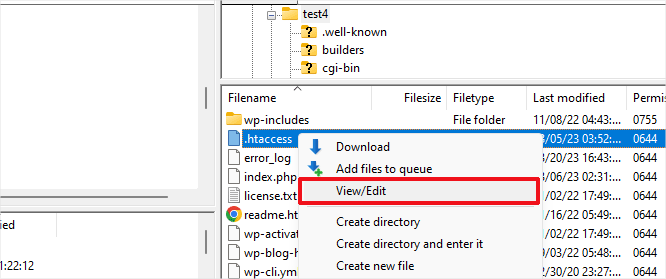
Il file vuoto si aprirà in un editor di testo semplice come Notepad o TextEdit.
A questo punto, è necessario copiare e incollare il seguente codice al suo interno:
1 2 3 4 5 6 7 8 9 10 | # BEGIN WordPress<IfModule mod_rewrite.c>RewriteEngine OnRewriteBase /RewriteRule ^index.php$ - [L]RewriteCond %{REQUEST_FILENAME} !-fRewriteCond %{REQUEST_FILENAME} !-dRewriteRule . /index.php [L]</IfModule># END WordPress |
Questo codice è il set di regole predefinito utilizzato da WordPress. Non dimenticate di salvare le modifiche e di caricare il file sul server.
Ora è possibile visitare il sito web per verificare se l’errore del server interno è stato risolto.
In caso affermativo, allora datevi una pacca sulla spalla perché avete risolto l’errore interno del server.
Importante: prima di procedere con altre operazioni, assicuratevi di andare alla pagina Impostazioni ” Permalinks nell ‘area di amministrazione di WordPress e di fare clic sul pulsante Salva senza apportare alcuna modifica. In questo modo il file .htaccess verrà rigenerato con regole di riscrittura adeguate per garantire che le pagine dei vostri post non restituiscano un errore 404.
Se la soluzione per verificare la presenza di un file .htaccess corrotto non ha funzionato, allora dovete continuare a leggere questo articolo.
Aumentare il limite di memoria di PHP
A volte, l’errore interno del server può verificarsi se uno script consuma tutto il limite di memoria di PHP.
Il modo più semplice per aumentare il limite di memoria di PHP è modificare il file wp-config.php. Se siete principianti, fate attenzione a questa operazione. Seguite attentamente queste istruzioni, perché anche piccoli errori nei file principali di WordPress possono danneggiare il vostro sito.
Per iniziare, è sufficiente collegarsi al proprio sito web WordPress utilizzando un client FTP o l’applicazione File Manager nel pannello di controllo del proprio account di hosting.
Il file wp-config.php si trova nella cartella principale del vostro sito web. Fate clic con il tasto destro del mouse su di esso e selezionate “Scarica”. In questo modo vi assicurerete di avere un file di backup nel caso in cui qualcosa vada storto.
Una volta salvato, è possibile fare clic con il pulsante destro del mouse e selezionare “Visualizza/Modifica”.
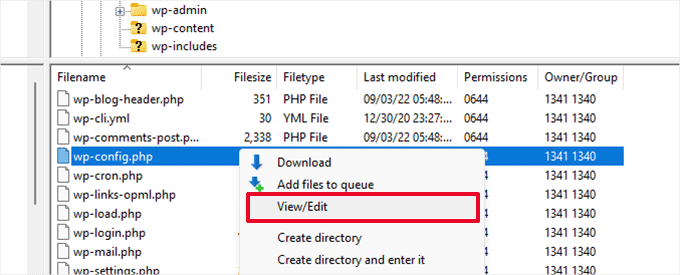
All’interno del file wp-config.php, è necessario aggiungere il seguente codice appena sopra la riga che recita: “Questo è tutto, smettete di modificare! Buona pubblicazione”:
1 | define( 'WP_MEMORY_LIMIT', '256M' ); |
Per maggiori dettagli, consultate il nostro tutorial su come aumentare il limite di memoria PHP in WordPress.
Nota: se 256M non risolve il problema, provare ad aumentare a 512M.
Se l’errore del server interno viene visualizzato solo quando si tenta di accedere all’amministrazione di WordPress o di caricare un’immagine in wp-admin, allora è necessario aumentare il limite di memoria seguendo questi passaggi:
- Creare un file di testo vuoto sul computer e chiamarlo php.ini.
- Incollare questo codice: memoria=256MB
- Salvare il file
- Caricate il file nella cartella /wp-admin/ tramite FTP.
Se l’aumento del limite di memoria ha risolto il problema, allora il problema è stato risolto solo temporaneamente. È ancora necessario trovare la causa che sta esaurendo il limite di memoria.
Potrebbe trattarsi di un plugin mal codificato o anche di una funzione del tema. Vi consigliamo vivamente di chiedere alla vostra società di web hosting WordPress di esaminare i log del server per aiutarvi a trovare la diagnostica esatta.
Se l’aumento del limite di memoria di PHP non ha corretto il problema, è necessario risolvere altri problemi.
Disattivare tutti i plugin di WordPress
Se nessuna delle soluzioni precedenti ha funzionato, è molto probabile che l’errore sia causato da un plugin specifico installato sul vostro sito web.
È anche possibile che si tratti di una combinazione di plugin che non funzionano bene tra loro.
Se potete accedere all’area di amministrazione di WordPress del vostro sito web, potete semplicemente andare alla pagina dei plugin e disattivare tutti i plugin di WordPress.
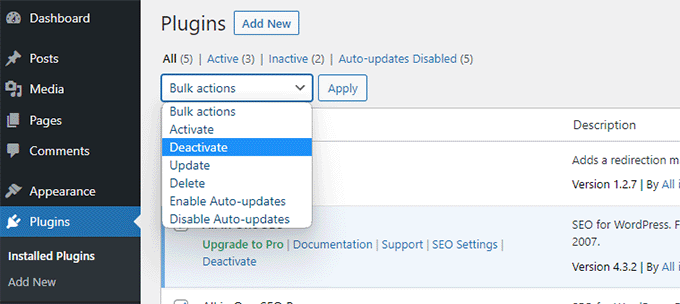
Tuttavia, se non riuscite ad accedere all’area di amministrazione di WordPress, potete disattivare tutti i plugin di WordPress utilizzando l’FTP.
È sufficiente collegarsi al proprio sito Web WordPress utilizzando un client FTP o l’applicazione di gestione dei file nel pannello di controllo del proprio account di hosting.
Una volta collegati, navigare nella cartella /wp-content/ e rinominare la cartella plugins in plugins.deactivated.
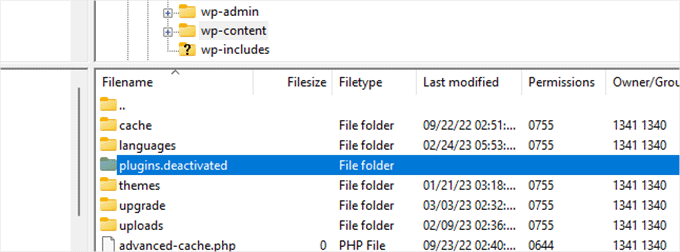
WordPress cerca i plugin nella cartella plugins. Se la cartella plugins non viene trovata, disattiverà automaticamente tutti i plugin.
Ora potete provare a visitare il vostro sito web per verificare se questo ha risolto l’errore del server interno sul vostro sito web.
Per ripristinare tutti i plugin, è sufficiente rinominare la cartella ‘plugins.deactivated’ in plugins.
I plugin verranno ripristinati, ma saranno ancora disattivati.
Ora è possibile attivare i singoli plugin e visitare il sito web per capire quale plugin sta causando l’errore interno del server.
Per maggiori dettagli, consultate la nostra guida su come disattivare tutti i plugin di WordPress senza wp-admin.
Se la disattivazione di tutti i plugin non ha risolto l’errore interno del server sul vostro sito web, continuate a leggere.
Passare a un tema WordPress predefinito
Una possibile causa dell’errore del server interno potrebbe essere un codice del tema di WordPress.
Per determinare se questo è il caso, è necessario cambiare il tema con un tema predefinito di WordPress.
Se avete accesso all’area di amministrazione di WordPress, andate alla pagina Aspetto ” Temi. Se è già installato un tema predefinito, è sufficiente fare clic sul pulsante Attiva per cambiare il tema.
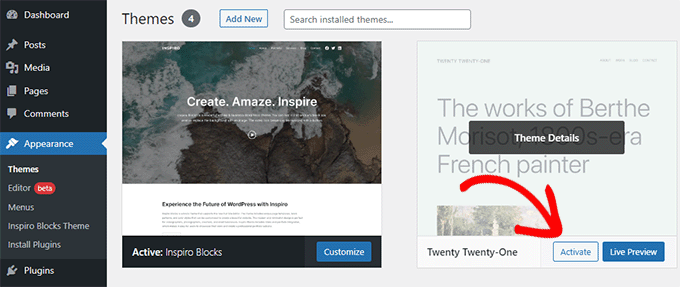
Se non avete installato un tema predefinito, potete fare clic sul pulsante “Aggiungi nuovo” in alto e installare un tema predefinito (Twenty Twenty-Three, Twenty Twenty-Two e così via).
Se non avete accesso all’area di amministrazione di WordPress, potete comunque passare a un tema predefinito.
È sufficiente collegarsi al proprio sito web WordPress utilizzando un client FTP e navigare nella cartella /wp-content/.
Fare clic con il pulsante destro del mouse per selezionare la cartella dei temi e scaricarla sul computer come backup.
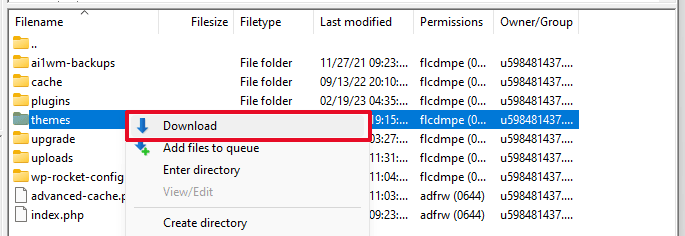
Successivamente, è necessario eliminare la cartella themes dal sito web. Una volta eliminata, creare una nuova cartella themes.
La nuova cartella dei temi sarà completamente vuota, il che significa che al momento non è stato installato alcun tema di WordPress.
Successivamente, è necessario visitare la directory dei temi di WordPress e scaricare un tema predefinito di WordPress sul computer.
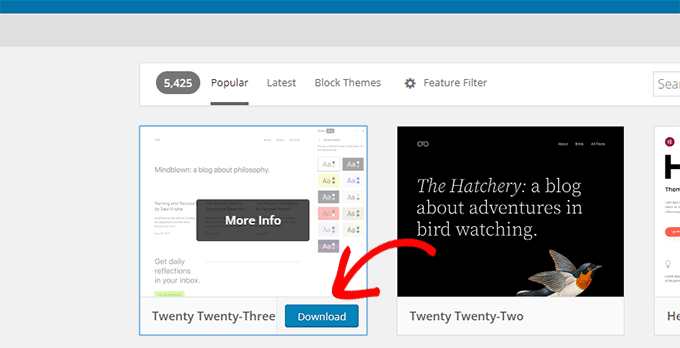
Il vostro browser scaricherà quindi il tema come file zip sul vostro computer.
Individuare il file sul computer e decomprimerlo. Gli utenti di Windows possono decomprimere il file facendo clic con il pulsante destro del mouse e selezionando “Estrai tutto”. Gli utenti Mac possono fare doppio clic sul file zip per estrarlo.
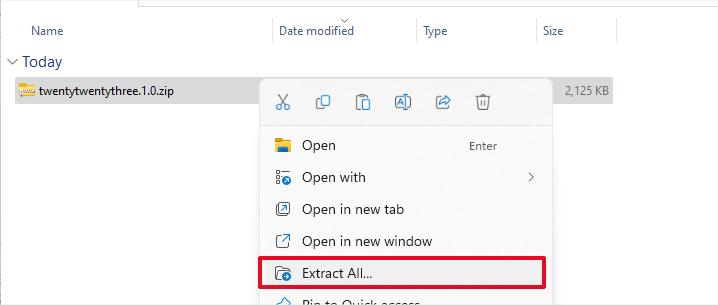
Ora vedrete una cartella contenente il vostro tema di WordPress.
Passare nuovamente al client FTP o al File Manager e caricare questa cartella nella cartella vuota dei temi.
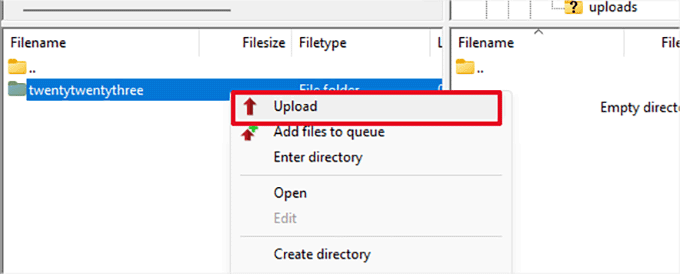
Una volta caricato, WordPress inizierà automaticamente a utilizzare il tema predefinito.
Ora è possibile visitare il sito web per verificare se l’errore del server interno è stato risolto.
Se non funziona, potete ricaricare i vostri temi WordPress dal backup o tornare al tema che stavate usando.
Non preoccupatevi. Ci sono ancora alcune cose che potete fare per risolvere l’errore.
Ricaricamento dei file del nucleo
Se le opzioni dei plugin e dei temi non hanno risolto l’errore interno del server, è opportuno ricaricare le cartelle /wp-admin/ e /wp-includes/ da una nuova installazione di WordPress.
Questa operazione NON rimuove le informazioni, ma può risolvere il problema nel caso in cui un file sia danneggiato.
Per prima cosa, è necessario visitare il sito web WordPress.org e fare clic sul pulsante “Download”.
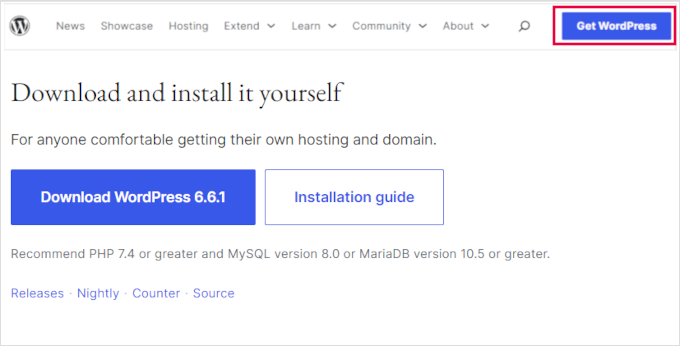
Questo scaricherà il file zip di WordPress sul vostro computer.
Procedere con l’estrazione del file zip. Al suo interno troverete una cartella wordpress.

Successivamente, è necessario collegarsi al proprio sito web WordPress utilizzando un client FTP.
Una volta collegati, accedere alla cartella principale del sito web. È la cartella che contiene le cartelle wp-admin, wp-includes e wp-content.
Nella colonna di sinistra, aprite la cartella WordPress sul vostro computer.
Ora è necessario selezionare tutti i file presenti nella cartella di wordpress e caricarli sul sito web.
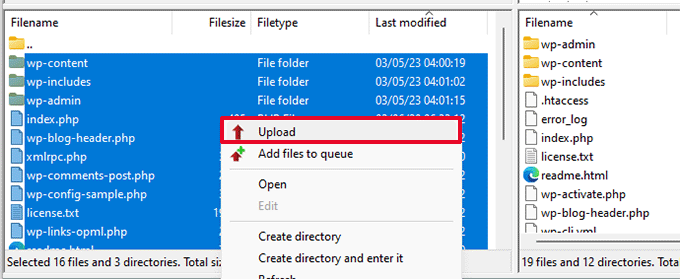
Il vostro client FTP trasferirà ora queste cartelle sul vostro server.
Verrà chiesto se si desidera sovrascrivere i file. Selezionare “Sovrascrivi”, quindi selezionare “Usa sempre questa azione” e selezionare la casella di controllo “Applica solo alla coda corrente”.
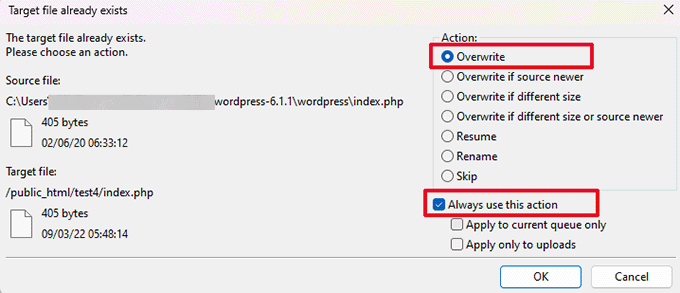
Il vostro client FTP sostituirà ora i vecchi file di WordPress con nuove copie fresche.
Se i file di WordPress sono stati danneggiati, questo passaggio risolverà l’errore interno del server.
Abilitare i log di debug in WordPress
WordPress è dotato di un sistema integrato per mantenere i log per il debug.
È possibile attivarlo utilizzando il plugin WP Debugging. Per maggiori dettagli, consultate la nostra guida su come installare un plugin di WordPress.
Una volta attivato, il plugin attiva i log di debug sul vostro sito web WordPress.
Se non avete accesso all’area di amministrazione del vostro sito WordPress, potete attivare il debug aggiungendo il seguente codice al file wp-config.php:
1 2 | define( 'WP_DEBUG', true);define( 'WP_DEBUG_LOG', true); |
Una volta attivati i log di debug, è possibile visualizzarli utilizzando un client FTP e navigando alla cartella /wp-content/.
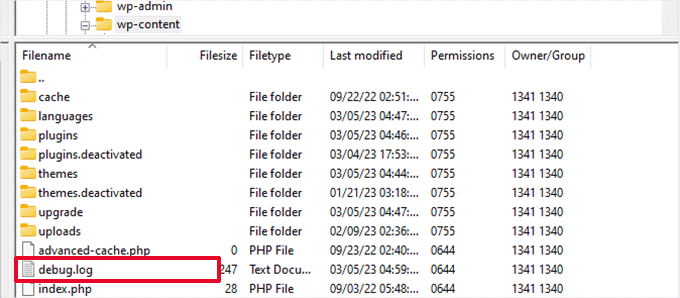
Il file di log di debug può essere aperto in un editor di testo e mostrerà un elenco di errori e avvisi che si verificano sul sito web.
Alcuni errori e avvisi possono essere incidenti innocui che non devono essere risolti. Tuttavia, se il vostro sito web presenta un errore interno del server, questi possono indicarvi la giusta direzione.
Chiedete al vostro fornitore di hosting
Se tutti i metodi non riescono a risolvere l’errore interno del server sul vostro sito web, allora è il momento di chiedere aiuto.
Contattare il team di assistenza del web hosting, che sarà in grado di controllare i registri del server e individuare la causa principale dell’errore.
Se volete continuare a risolvere i problemi da soli, consultate la nostra guida definitiva alla risoluzione dei problemi di WordPress per i principianti.
Video tutorial
Se questo articolo vi è piaciuto, iscrivetevi al nostro canale YouTube per le esercitazioni video su WordPress. Potete trovarci anche su Twitter e Facebook.





Aamir
I was also facing the problem. As said above it was because of a plugin(“Contact Info Widget”) which was not working fine. So I deleted the plugin files from FileManager and now its solved. Thanks for the useful tips.
Harsh
I have Tried All the Points still I haven’t Got the solution,
I have renamed the .htaccess file, plugin folder, gave permission 755 to 777, increased memory limit in the wp-config file but the site is still showing error. below is the screenshot.
WPBeginner Support
Hi Harsh,
Please contact your hosting provider, this could be an issue on their end.
Admin
Logan Izador
Thank you so much! Wasted 2 hours with Hostgator for them to give me the wrong info smh. All I had to do was follow your steps to delete the plugins through my cpanel. I went from there to figure out which plugin was corrupt.
umar aziz
i have got 500 internal error only on orders tab of woo-commerce.
unable to see the orders.
kindly help amd guide me how to resolve it
Marcia
Hello, I tried to follow your instruction on How to Check Your Maximum File Upload Size Limit in WordPress? But his totally crashed my website and now I cant even access it. Please URGENTLY advise how I am to fix this problem……
WPBeginner Support
Hi Marcia,
If you are seeing a white screen with no error message, then please see our guide on how to fix WordPress white screen of death.
Admin
Bart
You can also check your PHP version, our hosting provider pr-actively changed the default PHP version and WordPress and plugins didn’t support that. After upgrading WordPress and all the plug-ins, the site runs as normal again!
(only my ADMIN page didn’t work anymore)
Best regards
Sean zangana
Bart , i want to thank you , God bless you .
Moses
having some issues with my website if I click on any post it just refresh my page, even if I enter a post url it’s still the same please help me out
WPBeginner Support
Hi Moses,
Please try steps in our WordPress troubleshooting guide, it will help you figure out what’s causing the issue.
Admin
Sahil Ansari
My Web Is not solved 500 error
This page isn’t working
Currently unable to handle this request.
HTTP ERROR 500
erorr log shoing this messege wp-settings.php on line 166
Olan
This was very helpful for me, settings, permalinks fixed the 500 internal issues
Albena Vassileva
Great info, thanks! The third option worked for me which was kind of expected because I lost my admin panel after updating some plugins.
Gerrit
After I did everything here my site was still not working so I called my hosting provider and after a while we figured out that it I could finish my migration by manually setting the base-url in the .sql and then going into to the permalinks part en saving it. This fixed it all. I’ve noticed 1 time before that re-saving the permalinks sometimes helps overcome errors. I hope this is useful for some people.
Kevin
It worked, thanks!
Editorial Staff
Likely it’s an issue with a plugin that’s interacting with the customizer.
Admin
Ion
I have tried everything they recommend and it does not work. When activating any theme, it gives error 500. I can not generate the .htaccess because my server works with nginx. I have consulted the guide that recommends wordpress but I can not make it work. The site worked until I wanted to update the theme.
Americo Mendes
Very first step on the video worked – corrupt .htaccess file.
I thought I was going to be redesigning the site. Thank you folks!
Andrew
First issue was a theme caused the 500. Went into FTP and removed it and all was good. I really liked the theme and thought it might have simply been a memory issue (as the site was working just not the admin sections) so I changed the php.ini file under admin to memory=128MB. Now nothing works. help?
help?
Bret
have you tried to upgrade the memory to 256MB and increase the upload limit files to 50M ? that might be help you.
Yanick Proulx
I understand everything exept one thing…
Where can i find all the stuff to connect to ftp (adress, log and pw)
I am using wordpress on godaddy hosting and since a plug in update crashes i can acces the site and the wp-admin section as well.
Thank you
WPBeginner Support
Hello Yanick,
Usually when you sign up for hosting account you get all this information in an email. If you can’t find it, please contact your hosting provider and they will be able to find it for you.
Admin
Shrijan
I am getting 500 internal server error while accessing /admin url on virtual host in my local machine. Though my previous site was working fine on XAMPP in windows. Any suggestions..
Dana S
Perfect. Thanks a lot for help.
miranda
what if your using starfield technologies from godaddy i have this problem i worked so dam haddddddddddddddd on this site it all happend when i udated a plugin help please
Grace
So…. for beginners who have no idea what ftp is or where to find that or how you would find a .htaccess file… I am already lost at step 1.
WPBeginner Support
Hi Grace,
Please see our guide on using FTP to upload and edit WordPress files.
Admin
Ankur Thakur
Hi editorial staff,
Who so ever you are…
I just want to hug you and say a million thanks
to save my blog!!!
God bless you
Love you…
Please provide your email… to say personal thanks
WPBeginner Support
Hi Ankur,
You are welcome We are glad you found the article helpful.
We are glad you found the article helpful.
Admin
Andrew
Thank you so much… the problem was with the htaccess. renaming htaccess couldn’t work so i went to settings>permelinks and simply saved without making any changes and it worked perfect.
God bless you
Aqib
Hi, Nothing works for me
Ernest
Currently, my website cannot be reached. It has an connection refusal error. I cannot even login to the WordPress Admin dashboard. Does anyone have any solutions?
Monish
What can be the cause of internal server error. If it works fine with hostgator shared server. And same website shows internal server error in Godaddy shared delux server.
Traci
Thanks for providing this information. I started troubleshooting, then realized another site on the same host was getting the same message. Turns out it was a DB server issue on the host’s end!
Aadam Jaalatoo Fardoo
This page isn’t working is currently unable to handle this request.
HTTP ERROR 500 this is the error message i get when i load the subdomain url, i cant access anything.
I have tried to edit, delete, reinstall htaccess, still no result, there is no theme, or plugin to even disable, since i havent even access wordpress setup page.
pls assist
WPBeginner Support
Hi Aadam,
Please contact your WordPress hosting provider. There could be some configuration causing this issue either with your WordPress install or at their end.
Admin
Nur
Wow it works!!
james
This page isn’t working is currently unable to handle this request.
HTTP ERROR 500
I have a prestashop site on my main domain, recently created a subdomain, after installing WordPress, this is the error message i get when i load the subdomain url, i cant access anything.
I have tried to edit, delete, reinstall htaccess, still no result, there is no theme, or plugin to even disable, since i havent even access wordpress setup page.
pls assist
Castro
Hello, I contacted my hosting server provider and this error log was sent to me, cause i was getting 500 internal server error message. “PHP Fatal error: Uncaught Error: Call to undefined function wp_start_scraping_edited_file_errors() in /home/politic6/public_html/wp-settings.php:297
Stack trace:
0 /home/politic6/public_html/wp-config.php(90): require_once()
1 /home/politic6/public_html/wp-load.php(37): require_once(‘/home/politic6/…’)
2 /home/politic6/public_html/wp-blog-header.php(13): require_once(‘/home/politic6/…’)
3 /home/politic6/public_html/index.php(17): require(‘/home/politic6/…’)
4
thrown in /home/politic6/public_html/wp-settings.php on line 297”
HELPPPPPPPP!!!!
WPBeginner Support
Hi Castro,
Please follow the steps in our WordPress troubleshooting guide. It will help you figure out the issue and then you will be able to fix it.
Admin
Cherissa
Normally the first fix, recreating the htaccess file always does the trick for me, but this time I had to go completely down the list of fixes. After beating my head into a wall several times, ONLY thing that worked was to reinstall core files, create new htaccess files AND once I got into wp-admin page re-run the WordPress updater again. THEN everything was finally restored. THANK YOU for the well written, life saving checklist!!!!
Hafiz Naser Aslam
The most easy way to resolve the 500 internal server error is make debugging on from wp_config.php i.e WP_DEBUG true
Sibongile
Wow thanks
// Enable WP_DEBUG mode
define( ‘WP_DEBUG’, true );
this solved it for me as I was able to track the error and fix within minute
Nelson Mbembe
Re-uploading Core Files worked for me thanks !
David
Thanks for your article.I just resolved my problem by delete the plugin.
Farshid
Thank you so much, man. I solved it.
Muhammad Abbas
This is one of the great article, this really help me out to solve my problem on my wordpress site great.
Well appreciated.
Edgar Ogba
Deactivating plugins worked for my site
Gabriel
Thanks a lot. As I am new was very shoked due to this problem. But after following your guide line I got help. Thanks.
Haris
I recently experieinced this problem. I edited function.php file and added ?> in the end to end php tag. That caused this error. if it helps someone!
Thank you!
Julia
I did all the steps in this blog post but nothing worked. I saw your comment, and decided to re-upload my functions.php file (I also re-wrote the php tag). My website is now working again. Thank you so much for this helpful tip
Pushpendra
Thanks a lot! Saved me from going into panic. My site was getting huge number of malicious login attempts and I turned up security on high. After few hours I got notification of this error and website not loading.
I was about to open a ticket but found this post and Voila htaccess solution worked! Thanks again!
Sam A.
Thanks for this. I solved the issue.
Yoav
Thanks for the article. In my case the error was caused by `short_open_tags` set to `Off` in php.ini. Setting it to `On` solved the issue. I guess some plugins use `<?` or `<?=` tags. Cheers
Adeshola
Thanks but how do you get fresh wp-admin and wp-includes folders?
Cindy
Thank you!
Ramon de Holanda
Real thanks, works for me
Patrick
Thank you so much for this!
Increasing the PHP Memory Limit worked like a charm!
Kris
It’s working thank you
I migrated to a VPS.
I got an issue when I want to change the setting on any plugins, end up with error 500. But if I checked at htop, the server resources is not reach the limit, I’m using 4GB VPS 2core Linode, so it’s more that enough for small site like mine.
The php.ini trick works well, now I never got any error 500 anymore
jaiho
hi, thank you for your useful tips, this is the best site ever
Madusanka
It works for my site.